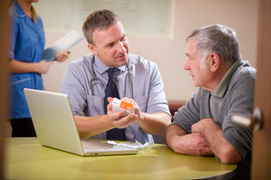The 9 Keys to Preventing Risks to You
 Have you or a loved one ever been harmed by a dangerous medication error?
Have you or a loved one ever been harmed by a dangerous medication error?
Considering an Institute of Medicine report that concluded at least 1.5 million Americans are harmed, sickened or killed annually due to errors made in prescribing, dispensing or taking a pharmaceutical drug — a somewhat conservative number issued 6 years ago — it may be only a matter of time before you or your friends and family are affected one way or another.
In fact, after reviewing some of the numbers below, you may wonder how you were lucky enough to avoid being sickened — or worse — by a prescription drug.
- More than half of all American adults take at least one prescription drug every week.
- 10 percent take more than 5 prescription medications.
- 20 percent take a drug they don’t need.
- 41 percent of fatal medication mistakes are related to taking the wrong dosage.
- Nearly 50 percent of the medication errors that resulted in fatalities were among patients older than age 60.
- The damage done to the American economy as a result of prescription errors: $4 BILLION annually.
When asked about the depth of the problems involving medication errors prior to unveiling the Safe Use Initiative in 2009, FDA Commissioner Dr. Margaret Hamburg said, “I was frankly stunned at the scope of the problem.”
Perhaps, the federal agency didn’t look hard enough: A Commonwealth Fund study issued seven years before that initiative by the Commonwealth Fund calculated 22 percent of Americans, or a family member, had experienced a medical error of some kind.
What You Can Do To Prevent Medication Errors
No doubt, medication errors have been around for much longer than we as a society have been aware of them. However, it’s not a foregone conclusion you or your family will be harmed by them either, so long as you take an active role in your health care by following these very simple, common-sense recommendations before and immediately after purchasing that next prescription.
1. Before leaving your doctor’s office, closely review any prescriptions he/she gives you to ensure you can read them.
If you can’t read your doctor’s handwriting, how can you expect a medical technician or pharmacist to do it either?
2. Keep track of all the medications, supplements and alternative treatments (herbs) you take in at least one safe, portable place you can carry to your doctor and specialists.
The beauty of owning a smartphone or tablet computer like an iPad is being able to carry all of this vital data with you to every appointment with a health professional. Just don’t forget to update it whenever necessary! Along those same lines…
3. Share that current list of medications with every health professional you see to prevent unexpected interactions.
Don’t hesitate to ask the health professionals on your health team about any interactions with other drugs or supplements you’re already taking as well as foods and any allergies.
4. Don’t be afraid to ask lots of questions before and after you leave your doctor’s office.
One good thing about all the data available about medication errors: Medical professionals at all levels of the food chain are more prepared than ever to answer your questions. If they balk when you ask questions, for the sake of your own good health and peace of mind, find a health professional who will listen and answer them.
 5. Read the medication guides attached to all new prescriptions carefully for mistakes your doctor or pharmacist may have made.
5. Read the medication guides attached to all new prescriptions carefully for mistakes your doctor or pharmacist may have made.
According to one case reported to the Institute for Safe Medication Practices, a consumer protected his health just by noticing the antibiotic he was prescribed by his doctor for a bladder infection (Noroxin) had been switched accidentally at the pharmacy to seizure medication (Neurontin). Don’t assume mistakes won’t be made in the pipeline. Check, recheck and check again.
6. Become an expert on the side effects of the medications you take.
While reviewing these guides, pay close attention to the section outlining all possible side effects of the medications you may be taking and what to do if they happen.
7. Never take medicine in the dark.
Unless you have special abilities (or night goggles) that enable you to see in the dark, take your medication in well-lighted places. No exceptions.
8. Follow medication instructions to the letter.
Don’t gamble with your health. Never take more or less than the prescription requires, and, always call your doctor before thinking about stopping one.
9. Review all medications you’re taking with your doctor frequently.
Don’t let a year go by without making an appointment with your doctor at least once to discuss all the medications you’re currently taking.
If the numbers and suggestions mentioned above aren’t compelling enough to make you more mindful about the medications you take, please review our recent post about the 20 Shocking Prescription Drug Statistics, including a unique list of facts compiled from various sources you won’t find anywhere else.
